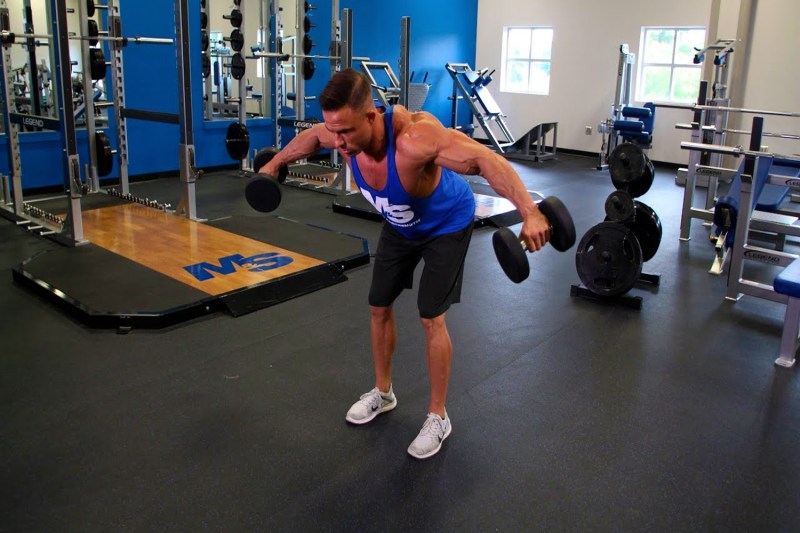When people work on building muscle, the shoulders are often overlooked, as there is a tendency to focus on the biceps and other key muscle groups. Strong boulder shoulders help form the upper part of the desirable V-shape physique. On top of the visual appeal, powerful shoulders also help improve your posture, lower your neck and back pain risk, and make lifting and carrying objects easier. Building these boulder shoulders requires dedication and the right targeted exercises that work all of the right muscle groups. Let’s take a look at the most effective exercises to achieve the iconic boulder shoulder look.
What are boulder shoulders?

Boulder shoulders is a bodybuilding term that refers to expansive, wide, rounded shoulders and impressive shoulder strength. You’ll need to work all three deltoid muscles in your shoulders to unlock your full boulder shoulder potential.
What are the benefits of boulder shoulders?

Strong boulder shoulders provide plenty of benefits, such as:
- A more muscular and stronger-looking upper body.
- Better posture and a lower risk of back and neck pain.
- Better balance and stability.
- Enhanced athletic performance.
- Improved ability to perform everyday functional tasks.
- Easier lifting, carrying, and moving of objects.
- Reduced risk of shoulder pain and injury.
Well-defined and muscular shoulders play an important role in supporting your upper body’s stability and strength.
Targeting your shoulder muscles

Your deltoid muscles cover three parts of your shoulder joint, the front, side, and back.
-
- Anterior or front deltoid — responsible for shoulder flexion.
- Lateral, medial, or side deltoid — responsible for abduction (lifting your arm laterally away from your body).
- Posterior or rear deltoid — responsible for shoulder extension.
Your deltoids work alongside your other shoulder muscles, such as your rotator cuffs, to help you lift your arm to the side and perform other movements. They’re also involved in activities like pulling, lifting, and pushing.
The three deltoids
For optimal results, you’ll need to work all three parts of your deltoids: the anterior, posterior, and middle. Targeting all three with the right exercises on your upper body and shoulder training days ensures your shoulders grow more evenly. Moves like the Arnold Press should make it into your training program because they hit all three deltoids.
As another example, front raises target your front deltoids, while lateral raises, dumbbell shoulder presses, and the barbell military press emphasize your middle deltoids.
How long does it take to get boulder shoulders?

When you put in the work, you should see some shoulder growth in the first few months, but achieving the big and broad boulder shoulders you’re striving for takes about 6-12 months or sometimes even longer.
How often should you work out your shoulder muscles?
Incorporate these shoulder-focused exercises into your routine two or three times a week for the best results. How many sets and reps you do depends on your fitness level, the weights you’re using, and other factors. Generally speaking, aim for two or three sets of 8-12 reps of each exercise.
Tips for building boulder shoulders
Here are some tips to help you build broad shoulders:
- Warm up and stretch before strength training to lower your risk of injury.
- Ensure you give those muscles sufficient time to rest and recover in between sessions.
- Start with a lighter weight and work your way up gradually as you develop strength and muscle mass.
- Focus on proper form to get the most out of each exercise.
- Make sure you hit all three deltoids.
- Level up your nutrition for the best outcome.
The best exercises for boulder shoulders

When you swell your shoulders with these effective exercises, you might need to go up a shirt size. The bicep muscles can’t steal all the spotlight when brawny, burly shoulders are around. Add these moves to your upper body and shoulder sessions.
Face pulls

The face pull works your rear deltoids, upper parts of your trapezius, and rotator cuffs. It’s a rewarding pulling exercise for leveling up your upper back and shoulder strength. They usually involve a cable machine, but you can also perform them with resistance bands.
How to do a face pull:
- Fasten the rope handle on the cable pulley machine slightly higher than your head.
- Take a step or two back and grip the ropes with an overhand grip.
- Keep your elbows up high and pull the rope towards your face. Rotate your arms so your arms come up as you get close to your head.
- The goal is to pull the rope handle until your hands are on either side of your head at the end of the movement.
- Carefully return the rope to the starting position.
- Repeat until you complete the set.
Arnold press

If you want shoulders like Arnold Schwarzenegger, you probably need to work out like him. He developed the Arnold Press as a variation of the overhead press, where you rotate your wrists while pressing the dumbbells up overhead. This move engages all three heads of your shoulder deltoids for a challenging shoulder workout. You’ll also work your triceps in your upper arms, your traps in your back, and your pectoral muscles in your chest. You can perform the Arnold Press sitting or standing using dumbbells.
How to do the Arnold Press:
- Stand with your feet about shoulder distance apart and hold two dumbbells.
- Engage your core and bring the dumbbells up to shoulder height with your palms facing you.
- Engage your shoulders and pull your shoulder blades together.
- Extend your arms above your head while rotating your wrists to the front.
- At the top of the movement, you should hold the dumbbells above your head with your palms facing forward.
- Carefully lower the dumbbells back to the starting position by rotating your wrists. Your palms should face you again.
- Repeat until you complete the set.
Military press

The barbell military press should be on your list for bulking your shoulders. It also targets your upper traps, upper chest, and triceps. You’ll improve your posture and work on your range of motion and balance as you hold the weight up overhead for a moment. This classic compound weight training exercise is necessary for a beefier upper body.
Here’s how to do the military press:
- Stand with your feet about shoulder distance apart.
- Grip the barbell with your hands a little wider than shoulder-width apart and your palms facing down.
- Squeeze your shoulder blades, glutes, and abs. Your knees should be slightly bent.
- Lift the weight up to your shoulders and make sure your forearms are straight and perpendicular to the ground.
- Engage your core and push the barbell up vertically over your head, straightening your arms.
- Hold the position for a moment.
- Carefully lower the weight back down to your shoulders.
- Repeat until you complete the set.
Dumbbell lateral raise

Dumbbell lateral raises are worthwhile when you want to engage your medial deltoids, which are a key part of the rounded boulder shape. Do not swing the dumbbells up too fast and focus on a controlled arcing motion. Cable lateral raises are also effective and provide constant tension on the medial deltoids throughout the movement. Research has shown lateral raises can help you build stronger and broader shoulders when performed regularly.
How to do a dumbbell lateral raise:
- With your arms by your sides, hold one dumbbell in each hand and slightly lean forward into the starting position.
- Slowly lift the dumbbells outwards until your arms are straight out by your sides, your upper arms are parallel with the floor, and you’re standing with your back straight.
- Slowly lower the dumbbells back to the starting position.
- Repeat until you complete the set.
Bent-over dumbbell reverse fly

The bent-over dumbbell reverse fly or the rear delt fly is a compound weight training exercise that works your posterior deltoids and improves your posture. Try to maintain a neutral spine throughout the movement. You can perform the rear delt fly with a cable machine, dumbbells, or a pec dec machine. It’s often called the rear delt fly because it’s a fruitful exercise for your rear deltoids on the back of your shoulders.
Here’s how to do the bent-over dumbbell reverse fly:
- Stand upright and hold a dumbbell in each hand.
- Bend forward, hinging at your hips, so you’re leaning forward, but your torso isn’t completely parallel or horizontal with the floor.
- Extend your arms straight down so your palms are facing each other.
- Engage your core, squeeze your shoulder blades, and lift the weights in a wide arc until your arms align with your back. (Think of this arcing motion like an eagle spreading its wings).
- Pause momentarily before lowering the weights and returning your arms to the starting position.
- Repeat until you complete the set.
Single dumbbell front raise

Front raises made the list because they engage your anterior deltoids to amplify shoulder width and definition. You’ll feel a workout in your shoulders as you lift the dumbbell with extended arms. This move helps you bulk up those boulder shoulders on the front side of your body. You can work one arm at a time or both arms.
How to do the single dumbbell front raise:
- Start standing up with your feet about shoulder-width apart and hold a dumbbell with both hands.
- Let the dumbbell hang down between your legs just in front of your thighs. In the starting position, your palms should face your thighs.
- Carefully lift the weights upward, keeping your arms extended.
- Raise the dumbbell until you reach about eye level.
- Pause momentarily before lowering the dumbbell back down to the starting position.
- Repeat until you complete the set.
Upright row

The upright row is a unique movement that targets your lateral deltoids, traps, and bigger upper back muscles. This exercise made it on our boulder shoulder list because it works your side deltoids and helps you practice keeping your torso upright for better posture.
How to do the upright row:
- Stand with your feet about shoulder-width apart.
- Let your arms hang down. With your palms facing your body, grip the barbell in front of your body with an overhand grip.
- Brace your abdominals, engage your core, and lift the barbell to your chin. Try to keep the barbell close to your body.
- Pause for a moment at the top of the movement.
- Carefully lower the barbell back to the starting position.
- Repeat until you complete the set.
Shoulder shrug

Shoulder shrugs aren’t just something people do when they have an attitude; barbell shoulder shrugs are a killer exercise for the tops of your shoulders. You’ll stimulate hypertrophy and improve your shoulder mobility.
How to do shoulder shrugs:
- Start standing upright, holding a barbell with your hands a little wider than shoulder distance apart.
- Keep your back straight and lift or ‘shrug’ your shoulders up. Bring your shoulders up to your ears as much as you can.
- Hold the position for a moment.
- Release your shoulders back down to the starting position.
- Repeat until you complete the set.




